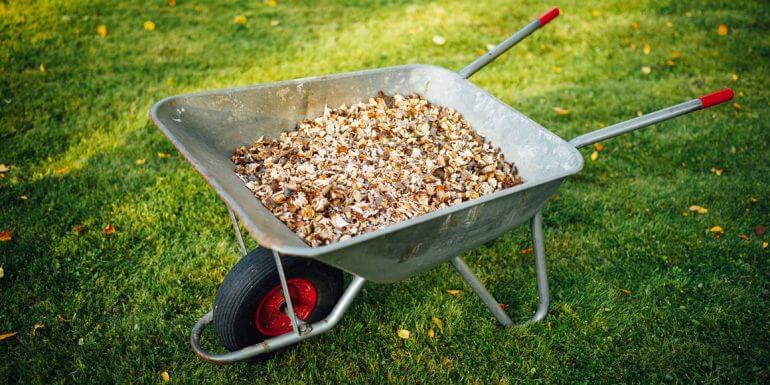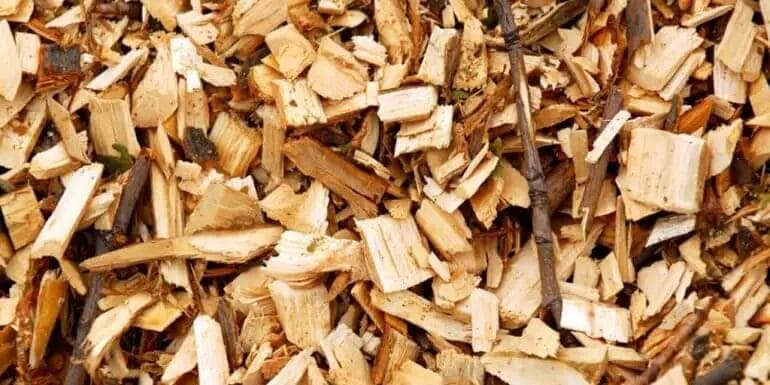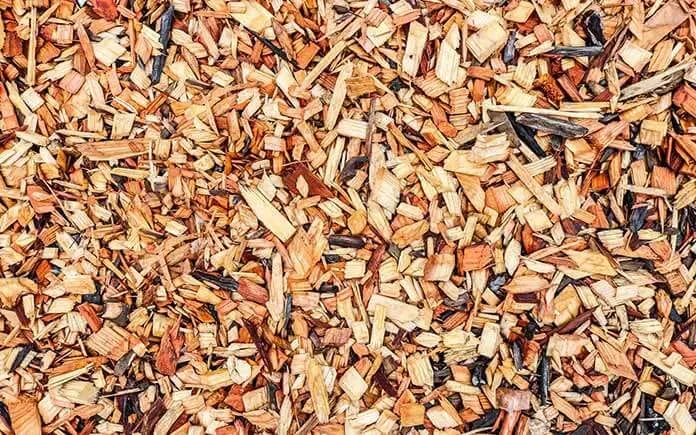Wondering what to do with the wood chips produced by your chipper? Don’t let them go to waste! Wood chips have a variety of practical uses that can benefit your garden and landscaping projects. From mulching to composting, these versatile chips can improve soil health, retain moisture, and suppress weeds.
One option is to spread the wood chips around your garden as a natural mulch. This will not only suppress weed growth but also regulate soil temperature and retain moisture, reducing the need for frequent watering. Additionally, as the wood chips decompose, they add valuable organic matter to the soil, enhancing its fertility.

Another option is to use the wood chips for pathways or walkways in your garden. By laying a thick layer of wood chips, you can create a visually appealing and durable surface that also helps prevent soil erosion. This is particularly useful in high-traffic areas, where traditional footpaths may be easily damaged.
If you’re into composting, you can also include wood chips in your compost pile. Mixing them with other organic matter, such as kitchen scraps and yard waste, helps achieve a balanced carbon-to-nitrogen ratio, promoting faster decomposition and nutrient-rich compost. This can then be used to improve the quality of your soil for planting.
Alternatively, you can donate the wood chips to local farms, community gardens, or landscaping companies. Many of these organizations are in constant need of organic materials like

Composting with Wood Chips
Composting is an excellent way to transform organic waste into nutrient-rich soil that can benefit your garden or plants. While there are various ingredients you can use in composting, wood chips are a popular choice due to their abundance and ability to enhance the composting process. In this section, we will explore how to use wood chips effectively in composting to create high-quality compost.
1. Understanding Wood Chips
Wood chips are small pieces of wood that result from tree pruning, trimming, or the processing of lumber. They are commonly used as a mulching material in gardens, but they can also play a vital role in composting. When used correctly, wood chips can provide carbon-rich material, promote aeration, and help maintain moisture levels within the compost pile.
1.1 Types of Wood Chips
There are various types of wood chips available for composting, including hardwood chips and softwood chips. Hardwood chips, such as oak or maple, contain more carbon and break down slowly, making them ideal for long-term composting. Softwood chips, like pine or cedar, decompose faster and provide a quick source of carbon for the compost pile. It’s essential to choose the right type of wood chips based on your composting needs and available resources.
2. Using Wood Chips in Composting
Now that we understand the importance of wood chips let’s discuss how to use them effectively in composting. Follow these steps to incorporate wood chips into your composting process:
2.1 Layering
Start by creating a compost pile or compost bin. Begin the layering process by adding a layer of wood chips at the bottom of the pile. This layer will act as a base, allowing airflow and drainage within the pile. Make sure to spread the wood chips evenly to facilitate the decomposition process.
2.2 Carbon to Nitrogen Ratio
Wood chips are considered a carbon-rich material, which means they have a high carbon to nitrogen ratio. To ensure optimal composting, it’s crucial to balance the carbon to nitrogen ratio in your compost pile. For every layer of wood chips added, add a layer of nitrogen-rich material, such as grass clippings or kitchen scraps, to maintain the balance.
2.3 Moisture Management
Wood chips have the tendency to absorb moisture and may cause the compost pile to become too dry. It’s essential to monitor the moisture levels regularly and adjust as needed. If the compost pile feels dry, add water to maintain the ideal moisture content required for decomposition.
2.4 Turning the Pile
To expedite the composting process and ensure proper decomposition, it’s crucial to regularly turn the compost pile. This helps in maintaining oxygen levels and promotes the breakdown of the organic materials, including the wood chips. Turn the pile every few weeks using a pitchfork or a compost turning tool.
2.5 Patience and Time
Composting is a natural process that takes time. Depending on various factors like temperature, moisture, and the size of the wood chips, the decomposition process may take several months to a year. Be patient and regularly monitor the progress of your compost pile.
3. Benefits of Using Wood Chips in Composting
Using wood chips in composting offers several benefits:
- Carbon Source: Wood chips provide a carbon-rich material, balancing the carbon to nitrogen ratio in the compost pile.
- Aeration: The bulky nature of wood chips creates air pockets within the compost pile, promoting oxygen circulation for beneficial microorganisms.
- Moisture Retention: Wood chips help retain moisture in the compost pile, preventing it from drying out too quickly.
- Slow Decomposition: Hardwood chips break down slowly, ensuring a long-lasting source of organic matter in the compost.
Summary
In summary, wood chips are a valuable addition to the composting process. They provide carbon-rich material, promote aeration, and help maintain moisture levels. By understanding how to use wood chips effectively in composting, you can create nutrient-rich soil to support healthy plant growth. Remember to layer the wood chips, balance the carbon to nitrogen ratio, manage moisture levels, turn the pile regularly, and allow time for the composting process to occur. Start composting with wood chips today and reap the benefits of sustainable gardening.

Mulching Benefits of Wood Chips
Using wood chips as mulch in gardens and landscaping can provide numerous advantages. Not only do wood chips enhance the visual appeal of your outdoor space, but they also offer several practical benefits. In this section, we will explore the various advantages of using wood chips as mulch.
1. Weed Suppression
One of the primary benefits of using wood chips as mulch is their ability to suppress weeds. When applied properly, wood chips create a barrier on the soil surface, preventing weed seeds from germinating and growing. The thick layer of mulch blocks out sunlight, which is crucial for weed growth. By preventing weeds from taking root, wood chips can significantly reduce the need for manual weeding and save you time and effort in maintaining your garden.
2. Moisture Retention
Wood chips act as a natural insulator, helping to retain moisture in the soil. The mulch layer acts as a barrier, reducing evaporation and keeping the soil moist for longer periods. This is particularly beneficial during hotter months or in areas with dry climates, where water conservation is essential. By helping to retain moisture, wood chip mulch can reduce the need for frequent watering, saving you both time and resources.
3. Temperature Moderation
In addition to moisture retention, wood chips also help moderate the temperature of the soil. The mulch layer acts as insulation, providing a buffer against extreme temperature fluctuations. During hot summer days, wood chip mulch can help keep the soil cooler, preventing damage to plant roots. Similarly, in colder climates, the mulch layer can provide insulation and protect plants from frost.
4. Soil Enrichment
As wood chips break down over time, they gradually release nutrients into the soil. This natural decomposition process adds organic matter to the soil, improving its overall fertility and structure. The gradual release of nutrients provides a slow and steady supply of essential elements, promoting healthy plant growth. This makes wood chip mulch an excellent choice for enriching garden beds and improving the long-term health of your plants.
5. Erosion Control
Wood chips can play a crucial role in preventing soil erosion. The mulch layer acts as a protective barrier, preventing rainwater from washing away the topsoil and exposing plant roots. By reducing erosion, wood chip mulch helps maintain the stability of slopes and minimizes soil loss. This is particularly important in areas prone to heavy rainfall or on sloping terrain.
6. Pest Control
Wood chips can also contribute to pest control in your garden. Certain types of wood, such as cedar, cypress, or pine, have natural properties that repel insects and pests. By using wood chips from these types of trees as mulch, you can deter pests from infesting your garden beds. Additionally, the mulch layer creates a physical barrier that makes it more challenging for pests to access plant roots and establish themselves in the soil.
In summary, using wood chips as mulch offers a range of benefits for gardens and landscaping. Not only do wood chips suppress weeds and retain moisture, but they also help moderate soil temperature, enrich the soil, control erosion, and contribute to pest control. By incorporating wood chip mulch into your outdoor space, you can create a healthier and more visually appealing environment for your plants.

Wood Chip Paths and Walkways
When it comes to creating beautiful and eco-friendly paths, wood chip paths and walkways are a fantastic option to consider. Not only do they add a natural and rustic charm to your outdoor space, but they also have numerous advantages that make them a popular choice among homeowners.
1. Benefits of Wood Chip Paths
Wood chip paths offer several benefits that make them a great choice for your outdoor areas:
- Cost-effective: Wood chips are an affordable alternative to other types of paving materials, making them a budget-friendly option for creating paths and walkways.
- Eco-friendly: Wood chips are a sustainable and environmentally-friendly choice. They are made from organic materials and can be sourced locally, reducing the carbon footprint associated with transportation.
- Natural and rustic appeal: Wood chip paths add a touch of natural beauty to your outdoor space. They blend seamlessly with the surrounding vegetation and create a charming rustic atmosphere.
- Soft and comfortable: Unlike hard surfaces like concrete or stone, wood chip paths provide a softer and more comfortable walking surface. They offer a cushioning effect, making them ideal for garden areas where you might want to walk barefoot.
- Easy installation and maintenance: Creating a wood chip path is relatively easy and requires minimal maintenance. Wood chips can be laid directly on the ground or on a weed barrier to prevent weed growth.
2. Inspiration for Wood Chip Paths
Whether you have a large backyard or a small garden, there are numerous ways to incorporate wood chip paths into your outdoor space. Here are some ideas to inspire you:
| 1. Curved Wood Chip Path | 2. Stepping Stone and Wood Chip Path |
|---|---|
 |  |
| Create a meandering path through your garden using wood chips. The curved design adds visual interest and enhances the natural flow of your outdoor space. | Combine stepping stones with wood chips to create a unique and charming pathway. The stepping stones provide a stable surface while the wood chips add a natural and rustic touch. |
3. Installation and Maintenance Tips
When installing wood chip paths, it’s important to follow these tips to ensure a successful and long-lasting result:
- Prepare the area: Clear the path of any vegetation, rocks, or debris. Level the ground if needed.
- Install a weed barrier: To prevent weed growth, lay a weed barrier fabric before spreading the wood chips.
- Spread the wood chips: Use a rake or shovel to evenly distribute the wood chips along the path. Aim for a depth of 2-4 inches for optimal results.
- Compact the wood chips: Use a tamper or simply walk on the wood chips to compact them slightly. This will help to create a more stable walking surface.
- Maintain the path: Regularly check for any areas where the wood chips may have thinned out or become uneven. Add more wood chips as needed to maintain the desired depth and appearance.
4. Conclusion
Wood chip paths and walkways add a touch of natural beauty to your outdoor space while being an eco-friendly and cost-effective choice. With their rustic charm and easy installation, they are an excellent option for creating attractive pathways in your garden. So why not consider incorporating wood chip paths into your landscaping plans?
Wood Chip Biomass: Utilizing Wood Chips as a Sustainable Energy Option
As the world continues to search for sustainable and renewable energy sources, wood chip biomass has emerged as a promising option. Wood chips, derived from various types of wood, including timber, logging residues, and forestry by-products, can be used as a renewable energy source to generate electricity, heat, and even biofuels. In this section, we will explore the potential of utilizing wood chips as a sustainable energy option.
1. Introduction to Wood Chip Biomass
Wood chip biomass refers to the process of utilizing wood chips as a source of energy. Wood chips are small pieces of wood that have been processed into a uniform size and shape. They can be produced from a variety of wood sources, including sawmill waste, logging residues, and forest thinnings.
2. Benefits of Wood Chip Biomass
Using wood chips as a renewable energy source offers several benefits:
- Sustainability: Wood chips come from a renewable source – trees. As long as responsible forestry practices are followed, wood chip biomass can be a sustainable energy option.
- Reduced greenhouse gas emissions: When compared to fossil fuels, wood chip biomass has a significantly lower carbon footprint. The combustion of wood chips releases carbon dioxide (CO2), but this is offset by the carbon absorbed by trees during their growth.
- Local sourcing: Wood chips can be sourced locally, reducing the reliance on imported fossil fuels. This enhances energy security and supports local economies.
- Waste utilization: By utilizing wood chips, waste wood materials that would have otherwise been discarded can be converted into a valuable energy source.
3. Applications of Wood Chip Biomass
Wood chip biomass can be used in various applications:
- Heat generation: Wood chips can be burned in specialized boilers to produce heat for residential, commercial, and industrial purposes. This can include space heating, hot water supply, and even process heat for manufacturing.
- Electricity generation: Wood chip biomass can also be converted into electricity through the combustion process. Biomass power plants utilize steam turbines to generate electricity, providing a renewable energy source to the grid.
- Biofuel production: Wood chips can be converted into biofuels, such as wood pellets, for use in transportation or heating applications. Biofuels derived from wood chips are a renewable alternative to fossil fuels.
4. Considerations and Challenges
While wood chip biomass shows great promise, there are several considerations and challenges to be aware of:
- Supply chain: Establishing a reliable and sustainable supply chain for wood chips can be a complex process, requiring coordination between forestry operations, wood processing facilities, and energy producers.
- Efficiency: The efficiency of wood chip biomass systems can vary depending on factors such as the quality of the wood chips, the design of the combustion system, and the maintenance of equipment.
- Emissions and air quality: Proper emissions controls are essential to minimize the release of pollutants during the combustion process. This includes the control of particulate matter, nitrogen oxides, and volatile organic compounds.
- Land use: Expanding wood chip biomass production may require additional land for forestry activities, raising concerns about deforestation and biodiversity loss. Responsible land management practices are crucial to mitigate these impacts.
5. Conclusion
In summary, wood chip biomass offers a promising and sustainable energy option. It presents numerous benefits, including its renewable nature, reduced greenhouse gas emissions, and local sourcing potential. Wood chip biomass can be utilized for heat generation, electricity production, and biofuel manufacturing. However, challenges such as supply chain management, efficiency optimization, emissions control, and responsible land use must be addressed. With further research, innovation, and investment, wood chip biomass has the potential to play a vital role in our transition to a more sustainable energy future.
FAQs
What should I do with wood chips from a chipper?
There are several options for wood chip disposal. You can use them as mulch in your garden to retain moisture and suppress weeds. They can also be composted to create nutrient-rich soil. Additionally, wood chips can be used as a path material or as a bedding material for livestock.
Can I use wood chips as fuel?
Yes, wood chips can be used as a fuel source. They can be used in wood-burning stoves, biomass boilers, or even as a fuel for outdoor fire pits. However, it’s important to ensure that the wood chips are properly dried and seasoned before using them as fuel.
How long do wood chips take to decompose?
The time it takes for wood chips to decompose can vary depending on environmental conditions and the size of the chips. Generally, it can take anywhere from several months to a few years for wood chips to fully break down. Smaller chips will decompose faster than larger ones.
Conclusion
In conclusion, there are several creative and practical uses for wood chips produced by a chipper. Whether you’re an avid gardener or a DIY enthusiast, these wood chips can be a valuable resource.
One option is to use them as mulch in your garden beds or around trees to help retain moisture, suppress weeds, and enrich the soil over time. Additionally, you can use wood chips as a natural pathway material in your garden, creating a rustic and charming walkway.
If you have a compost pile, incorporating wood chips can help balance the carbon-to-nitrogen ratio, speeding up the decomposition process. They can also be used to create natural play areas or as bedding material for livestock.
With a little creativity and resourcefulness, the wood chips from your chipper can find new life and serve various purposes, making them a valuable asset rather than a waste product.